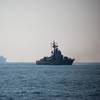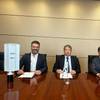Two recent European initiatives, both involving power systems supplier Wärtsilä Corporation, have given fresh impetus to the development and application of fuel cell technology aboard ship. The Finnish organization has entered into a pact with Danish firm Haldor Topsoe aimed at bringing cost-competitive fuel cell powering solutions to the market. It has also thrown its weight behind a major new, industry-wide European research program focusing on the technology for commercial shipping.
Increased European efforts to make the concept a cost-acceptable reality in waterborne transportation follow an early take-up in the naval field. A 250 kW Siemens fuel cell of the proton exchange membrane (PEM)-type is being installed as part of a hybrid power and propulsion configuration adopted for a German-designed series of newbuild submarines.
In the U.S., the federal government has this year given a fillip to the concept of fuel cell power in commercial marine applications, through its award of a $100,000 grant to the San Francisco Bay Water Transit Authority towards the development of a zero-emissions commuter ferry. The WTA is putting $25,000 from its own resources into the exercise, entailing the design, cost estimates and final drawings for a fuel cell-equipped ferry.
The new agreement between Wärtsilä and Haldor calls for the development of fuel cell products in the power range beyond 250-kW, for both the marine market and the distributed power generation sector. The claimed attributes of the technology are ultra-low emissions, and high levels of reliability and efficiency, although the collaborators acknowledge that this raft of benefits must be provided at acceptable cost if market penetration is to be achieved.
Haldor Topsoe has a long track record in the field of catalysts and energy conversion, and its work on fuel cells has concentrated within the past five years on solid oxide fuel cell (SOFC) technology. One element of its research and development activities has been a 10-year involvement in the Danish SOFC fuel cell program led by the Danish National Laboratory at Riso.
Readers of MR/EN may recall the firm's contribution to the seminal project involving the fitting of selective catalytic reduction (SCR) plant to the two-stroke MAN B&W engines in a series of 38,000-dwt bulk carriers delivered between 1989 and 1991 for transpacific trade into the San Francisco Bay area.
In addition to the cooperation with Haldor Topsoe, Wärtsilä is a participant in a new, European Union-aided pilot study to define the basis for the development of fuel cell systems for merchant ships. Implemented in June this year under the project name FC-Ship, the initiative has been prompted
by the perceived environmental benefits of fuel cell technology, as regards both exhaust emissions and noise. EU funding is expected to account for more than 50-percent of the budgeted costs of the 24-month program.
Drawing in 21 companies and institutions from EU countries and Norway, and coordinated from Oslo by the Norwegian Shipowners' Association, FC-Ship's initial objective is to identify and define demand for fuel cell systems in both propulsion and auxiliary applications, evaluate safety and operational needs, and assess the economic and environmental potential for waterborne transportation. Conceptual designs of fuel cell-powered vessel, including a passenger ship, are to be prepared, and project teams will undertake case studies and examine infrastructural requirements.
If the prospects are regarded as worthwhile, FC-Ship will provide a framework for follow-on research and development to help nurture the uptake of the technology by commercial marine users.
Simulating Evacuation
In Greek mythology, the Trojan hero Aeneas saved his father by carrying him out of the burning ruins of Troy on his shoulders. The story of Aeneas has inspired the name of a new computer tool developed in Germany for simulating and optimizing passenger evacuation from ships. Aeneas offers shipyards and shipowners a means of performing fast and reliable analysis of the evacuation process, providing increased planning security at the early design stages of a newbuild project, as well as assisting ongoing safety management and training functions.
Aeneas is the product of technical cooperation between classification society Germanischer Lloyd and pedestrian flow simulation specialist TraffGo, an offshoot of the University of Duisburg. It is designed to provide a realistic representation of evacuation processes by identifying optimum exit routes and possible bottlenecks. Fundamental to the whole are innovative computer models, known as 'agents', which each represent the main characteristics and actions of a passenger proceeding through the corridors, stairways, public spaces and decks of a ship in accordance with given scenarios.
Many yards and ship operators will regard applications of the system in the field of safety management, such as for crew training purposes and for the improvement of emergency preparedness, as potentially even more important than the obligatory IMO evacuation analysis, where required. The versatile tool can also be used for operational needs, as in determining boarding and disembarkation times, or assessing passenger flows in public spaces, for instance.
Purposeful Chinese
The growing stature of Chinese shipbuilding on the international stage is all the more impressive for the extent to which the industry is embracing specialized vessel categories and higher added-value forms of tonnage.
Whereas the output spread from other parts of the Far East is limited by the huge volume production requirements of large yards engaged in the low-margin fields of ship construction, China's shipyards are developing an ever-wider portfolio. A growing capacity is underpinned by a propensity for meeting shipowners' specific needs across a very broad platform. To a large extent, the development is export-led, although the response to new domestic needs is also cultivating a broader industrial marine base.
One example is provided by Jiangnan Shipyard's current construction of the first of possibly two train ferries to link the Chinese mainland with the southern island of Hainan. This pioneering project, based on a home-grown design, entails a vessel type offering a loading capacity for about 40 railfreight wagons, or alternatively 50 light trucks, plus facilities for 1,200 passengers.
Technical design work has also been carried out elsewhere in China for another infrastructural scheme, which envisions a new breed of rail ferry for a much longer route between Dalian and Yantai, across the Bohai Strait.
Sophisticated domestic projects of this nature provide a technical basis for future forays into the export newbuild market.
Subscribe for
Maritime Reporter E-News
Maritime Reporter E-News is the maritime industry's largest circulation and most authoritative ENews Service, delivered to your Email five times per week










